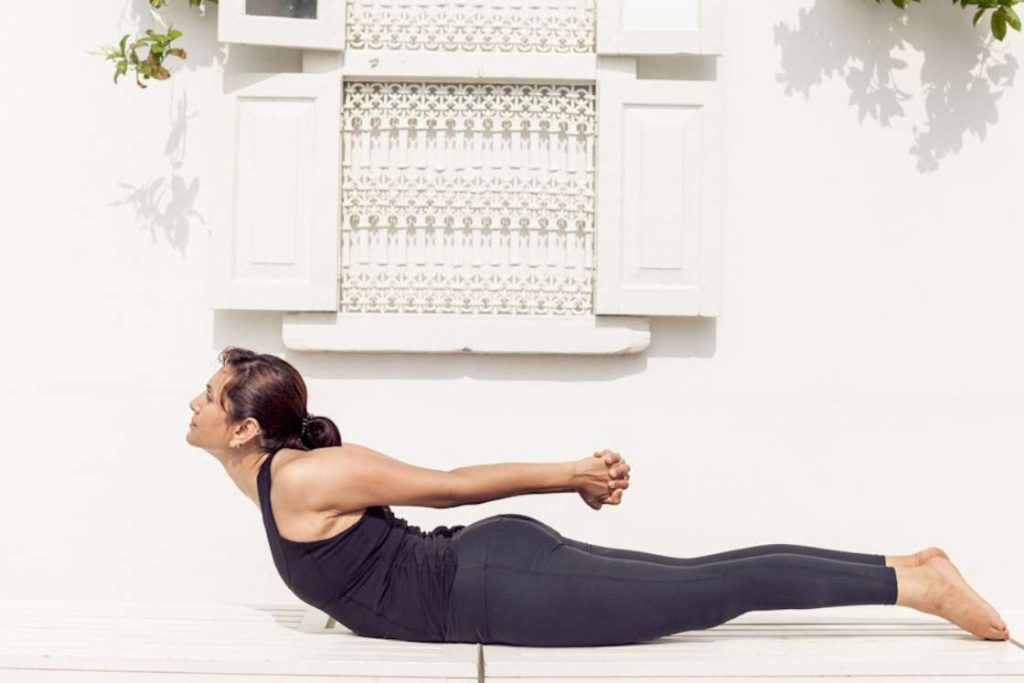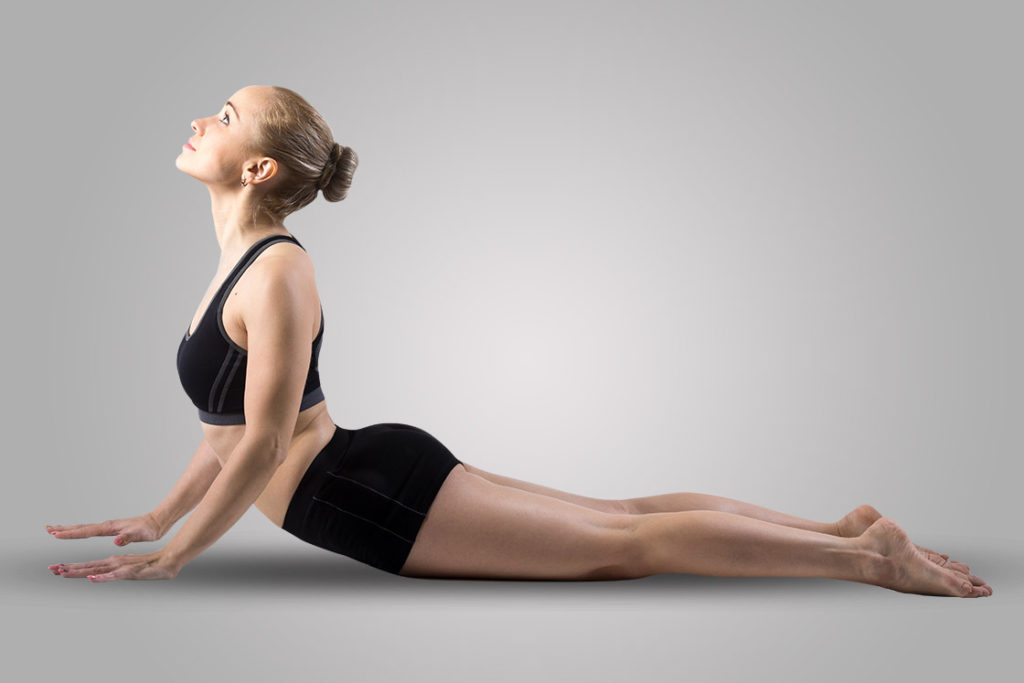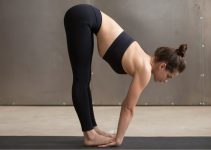
| Sanskrit Pronunciation | Sarpasana (Sar-pAA-Asa-nuh) |
| Meaning | Sarpa = snake / asana = pose |
| Pose Type | Backbending |
| Pose Level | Intermediate Pose |
| Stretches | Hamstring Muscles, thighs, Pelvic Muscles, glutes, buttocks, Hip flexors, shoulder, fingers, core, neck |
| Other Names | Sarpasana, Snake Pose. |
Snake pose is an intermediate prone yoga pose. It is an advanced variation of the Bhujangasana, which has almost similar benefits. This pose stretches the lungs, shoulders, chest, and abdomen with increased influence on the thoracic region. Sarpasana strengthens the spine and also helps in relieving stress.
Due to its dynamic approach, snake pose energizes the practitioner’s body and for the same reason, it has been included in the flow yoga sequence. In classical Yoga, Sarpasana is considered as the building block for the further advanced practice of back bending Posture.
Sarpasana Meaning & Significance
The Sarpasana is a Sanskrit term in which Sarpa means ‘Snake’ and ‘Asana’ means ‘Pose’. So, the practitioners practicing this pose resemble the snake where the extended hands behind create a pull to lift the hood of the snake.
Snakes are reptiles that crawl and remain attached to the earth. This resembles the humble aspect of practicing snake pose, which helps in keeping one’s ego in check.
Historically, snakes or serpents represent fertility and creative life force or subtle energies. In Yoga, the coiled-up snake symbolizes Kundalini (Subtle life force sitting at the Mooladhara). But the symbolic representation of this aspect is because, when celestial beings (those who are more conscious and capably superior than humans) entered this dimension they took the form of a snake.
Apart from that, the snakes shed their skin through sloughing. They symbolize transformation, fertility, and rebirth. In this way, practicing snake pose refines the physical, mental, and spiritual state by the transformation and makes the practitioner more fertile and alive than before.
Difference between Sarpasana and Bhujangasana
The Sarpasana is an advanced variation of Bhujangasana. Both the poses are practiced prone, but there are some differences in approaching and being in the pose. So we’ll go all the way through both postures.
- Hands in Bhujangasana are placed on either side of the body slightly outward from the shoulder, supporting the upper body weight. In sarpasana however, hands are interlocked behind the body and help in lifting the torso all the way through the spine.
- The spine in Bhujangasana is more curved than in sarpasana. From the front body, The hips touch the floor in the former pose while the floating ribs remain in contact with the floor in the latter one.
- Inner thigh, glutes, buttocks are more deeply engaged in snake pose than in cobra pose and both the feet are active and pointed in the back direction in the Sarpasana.
- The chest is more open and the chin faces the front in Sarpasana, whereas the chin faces the ceiling and the chest is less open in Bhujangasana.
- Most of the benefits of Sarpasana are similar to the Bhujangasana like a massage of the abdominal organs, core strengthening, and spinal flexibility. But the lower body in sarpasana is more activated than the bhujangasana, hence, strengthens the muscular aspects of that region.
Practice Guide
Practitioners can go through the following points in a sequence for the comprehensive and safe practice of the Sarpasana.
Contraindications of Snake Pose
Practitioners suffering from a hernia, peptic ulcer, and intestinal tuberculosis should avoid doing snake pose. Also, women with pregnancy and ongoing menstrual cycle refrain from practicing Sarpasana. Avoid practice in case of injury to the spine, lower back, and shoulder. Practitioners with heart conditions and those who have undergone recent abdominal surgeries should consult their doctors before doing this pose.
Preparatory Pose
Since snake pose is a gentle backbend, it requires an opening in the shoulder and sides intercostal muscles. For this, perform Adho Mukha Svanasana (Downward Facing Dog Pose), Bhujangasana (Cobra Pose), and Dhanurasana (Bow Pose) poses in preparation for snake pose.
How to Do Snake Pose (Steps)
- Begin by lying on your stomach on the mat. Your hands are beside the hips and legs straight in a manner sole facing the ceiling. Head down on either side of your body.
- Now, take your both hands behind just above the hips and entangled fingers into each other. Prepare here for the lift.
- Inhale, while retaining the breath lift your torso in a manner like head first and then the rest body. Use your core and back muscles to support the lifting here. Your legs should remain grounded, only the torso will be lifted.
- As you reach the final position, engage the shoulder blade, inner thighs, glutes, and buttocks to remain in the pose. Perform shallow breathing here to keep alive the pose.
- Now, extend interlocked arms backward as far as possible to refine the uplifting of the torso. Maintain here for 15 to 20 seconds.
- From here, exhale and come back by slowly releasing the extended hands. Relax the engaged muscles and lie down prone on the mat.
Follow Up Poses
To relieve the backbending effect of snake pose, come into any of these follow up poses after practice.
Precautions
- Practitioners should avoid lifting the torso off the floor with a jerk in the snake pose. It can cause injury in the lower back and neck.
- The final position of the snake pose makes breathing uncomfortable to the practitioners. Here, the diaphragm is under the pressure, so avoid long and deep breathing while in the final position.
- When coming back to the floor practitioners should keep their fingers entangled. Until or unless complete toso reach the floor because sudden release in the lifted position could cause back strain or head may hit to the floor.
Beginners Tips
- Use a rope – Beginners due to a stiffened shoulder might be having difficulty in grasping the hand behind the body. So, by grabbing a rope or strap in a clasped fist, one can reach each other or by sliding the fist to the middle. However, regular practice gradually releases the stiffness from the shoulder.
- Wall support – Weak core muscles and lack of spinal flexibility make it harder to lift off the torso from the floor. So, beginners can rest their torso against the wall and can turn their head to either side with hands beside the waist. This will establish flexibility in the spine and stretch the core as well.
- Use a pillow or bolster – Practitioners find difficulty in keeping the final pose due to pressure on the abdomen. It makes snake pose uncomfortable in breathing. They place a pillow or bolster under their floating ribs. This will distribute the weight of the torso on the entire props and assist in breathing during the practice.
Snake Pose Variations
The cobra pose and the Striking cobra pose are two easy variations of the base pose Sarpasana. These two can be practiced by the practitioners to develop spinal flexibility for more advanced back bending asanas.
1. Cobra Pose (Bhujangasana)

Sarpasana is the advanced variation of the bhujangasana and the same is applied for the Sarpasana. Here, the practitioners lift their body with the help of a palm placed slightly out of the shoulder along with the curved spine, legs straight, and gaze to the ceiling side.
In the sarpasana, the hands are entangled and clasped into each other behind and above the hips and torso lifted with legs straight. Whereas in Bhujangasana, the torso is supported over the hand placed out of the shoulder and legs straight in the back direction. The upper and lower body is actively engaged in the former posse while the upper body in the latter.
2. Striking Cobra Pose (Sashank Bhujngasana)
Striking cobra is a flow sequence pose with a combination of Shashankasana (Hare Pose) and bhujangasana (Cobra Pose). This is a dynamic variation of snake pose.
Practitioners begin it by going into the child pose and then by pressing the palms to come into the Bhujangasana. It has to be performed in a flow as per the ability.
Therapeutic Use
- Corrects spinal alignment – The snake pose practice corrects the bad posture by bending the spine in a backward direction. In this pose, the posterior part of the spinal column pushes the disc away from the spinal nerves and compresses the front of the vertebrae. This helps in realigning the vertebrae and at the same time stimulates the nervous system.
- Promotes deep breathing – Backbending in the Sarpasana stretches the thoracic region which results in expansion. It induces freer and deep breathing, which oxygenates the blood to a greater extent and strengthens the heart muscles. Hence, improves breathing as well as reduces the chances of heart diseases.
Snake Pose Benefits
The practice of snake pose has benefits concerning the respiratory, endocrinal, reproductive, digestive, and spiritual.
Below explained its benefits that can be acquired by the practitioner on regular practice.
1. Corrects the Round Shoulder
Due to inappropriate body positions, the body hunched forward over time. This is further pretended as the natural state by the body muscles and can be very harmful if left untreated. The practice of Sarpasana reestablished the previous spinal alignment that results in a normal shoulder.
In young children, snake pose helps to strengthen core muscles as well as the shoulders, back, and neck. It helps them differentiating between flexing and arching their back [efn_note] The Benefits of Teaching Yoga to Young Children with Special Needs: Developing an Appropriate Methodology https://infonomics-society.org/wp-content/uploads/ijtie/published-papers/volume-6-2017/The-Benefits-of-Teaching-Yoga-to-Young-Children-with-Special-Needs.pdf [/efn_note].
2. Develops Immunity and Resistance
According to one of the research [efn_note] A review of asanas referenced in ancient texts and a brief comparative study of selected asanas https://www.anantaajournal.com/archives/2019/vol5issue4/PartE/5-4-48-526.pdf [/efn_note], regular practice of Sarpasana develops immunity and resistance. The thoracic opening improves breathing, which further stimulates the interchange of innate immune system cells and components between lymphoid tissues and the blood compartment.
3. Helpful in Diabetes
Improper dietary habits i.e, excess intake of calories result in the deposition of fat, which along with no physical movements causes abnormalities in endocrine secretions. According to one of the studies [efn_note] Management of overweight and obesity through specific yogic procedures https://www.researchgate.net/profile/Yogesh-Deole/publication/265026464 [/efn_note], sarpasana stresses the pancreas gland. This in turn stimulates and secrete the insulin hormones in optimum amounts. Hence, overcome the condition of diabetes.
4. Activates Anahata Chakra
Snake pose is said to stimulate the Ida and Pingala Nadi by promoting deep breathing through both nostrils. This in turn stimulates the Sushumna and redirects the prana to reflect its effect on the Anahata Chakra and activates it in this asana practice. This gives empathy and compassion, and it’s responsible for your ability to forgive and accept.
5. Overcomes Digestive Ailments
The prone position of Sarpasana lays pressure on the abdominal area. This gives a massaging effect on the digestive organs, which keeps your organs intact and makes it easy for your organs to function. This helps your body absorb most of the nutrients from food and overcomes digestive disorders.
6. Strengthens Reproductive organs
The lower body is more active in sarpasana than in bhujangasana. This is the reason that portions continuously work to remain in the pose and the muscles call for the oxygen that is fulfilled by the blood circulation to the concerned region. This tones up the organs of male and female reproductive organs and ensures strengthening.
Conclusion
The sarpasana is an effective asana that improves the posture by adjusting the spinal alignment and flexibility. It is helpful in diabetes and also overcomes digestive ailments.
Anyone with some flexibility in their spine can practice this asana and can increase it by regular practice. Hence, sarpasana is an easy approach to the overall health and wellness of an individual.




